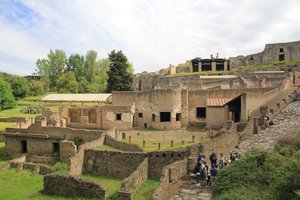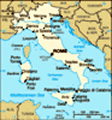Advertisement
Published: June 12th 2017

 Suburban baths
Suburban baths
Close to the main entrance to Pompeii is this well preserved building which used to be a public bathRuins en masse
We have for many years been thinking about going to Italy and visit the ruins of the Roman City
Pompeii. This spring Ake managed to get enough time off for a short trip and decided to make a visit to the famous site south of Naples. Emma could unfortunately not go with Ake this time because she had to work. But Ake enjoyed Pompeii so he doesn't mind going back there again some time in the future.
Since Pompeii is just outside Naples it made sense to see that city on the same trip because the third largest city in Italy is also is well worth visiting. That part of the trip will be covered in the next blog entry. Here I will write only about Pompeii.
The guidebook suggested an itinerary where I could first go to Pompeii and spend a few hours there. Then I could take a bus to the volcano Mount Vesuvius and thus seeing those two sites in the same day. But when I read that I thought "Yeah, right!". I mean there is no way squeeze in that much in one day. It

 The Basilica
The Basilica
This was the most important public building in Pompeii. It was the centre of the economic life and also housed the court turned out I was right. I ended up spending the entire day at Pompeii. I am sure most people would be happy spending only half a day or perhaps even less. But seven hours after entering the gates I was still exploring nooks and crannies and odd corners of the site. So the recommendation I would give to anyone reading this is: If you visit Pompeii allow yourself plenty of time to see the site because it is vast.
If you wish to read about Pompeii there are books and internet sites which you can use. Here I will only give you a very short introduction and top that up with some miscellaneous details I find interesting.
Pompeii was a city in the Roman Empire. It had a population of about 11,000 people and probably looked much like many other cities at that time in that part of the world. However the end of Pompeii was going to come more abruptly than for most other cities. Its ultimate fate was sealed by its location at the foothills of the live volcano Vesuvius. In the year 79 CE Vesuvius had a
large outbreak. The volcano ejected millions

 The Forum
The Forum
This is one end of the Forum, Pompeii's city centreof tons of rock, ash and pumice into the air and, so much that the city was completely buried. When the outbreak was over the layer of ash was several meters thick. It is a bit ironic that while this volcanic eruption completely destroyed the city it at the same time also preserved it. You might say that the ash layer stopped the time in Pompeii.
The heavy ash layer made most roofs collapse. But the walls of many houses survived and when the archaeologists removed the ash so much was still standing that it is easy to see what the city used to look like. The ash layer also preserved much art which in most other cities from this time has been lost.
Highlights and other points of interest (in the order they come in the photos):
•
Suburban baths - a well preserved building close to the main entrance to Pompeii.
• Statues - in public places and in some private homes the archaeologists have found statues when they excavated the site.
• Frescos - In many buildings and private homes art has been preserved. The frescos are still after

 Street
Street
Street lined with housesalmost 2000 years often in such good condition that both the colours and details are all there.
• Amfitheatres - three theatres have been uncovered. One rather small, one somewhat bigger and one large enough to hold the Super Bowl.
• Mosaics - Well preserved mosaics can be seen in many places in Pompeii. Several of the better ones have been removed though and can be seen in Naples National Archaeological Museum in Naples.
•
Graffiti - In many places graffiti has been preserved. If you thought it that was a new phenomenon, now you know it isn't.
• Casa di Venus - One of the houses is called Casa di Venus. It is named so because one of the walls in the house is adorned by a large fresco of the goddess Venus sitting on a Seashell.
• Dead people - Since the city was covered with a thick layer of ash without any warning the life in the city was more or less stopped instantly and entombed as it was. When Pompeii was excavated the archaeologists found many dead bodies. They only found the bones, no soft tissue was left. When the dead

 Ruins
Ruins
The city of Pompeii was covered by ash and although the heavy ash caused almost all buildings to collapse is also preserved the rest of the houses. bodies decomposed a cavity was created in the ash where the bodies had been. The archaeologists found out that they could pour plaster in the cavities they found and the cavities then effectively became a mold and the plaster took the exakt shape of the object which was trapped there in the first place.
• Amphoras - in shops and at home food was stored in big jars known as amphoras.
• Streets - In some of the streets the surface has been worn down so much from traffic that large ruts have formed. In some places stones have been laid to form a kind of crosswalks.
•
Villa of the Mysteries - One of the largest houses in Pompeii also holds some very impressive artworks. The name of the house comes from that they have interpreted the frescos in the house as showing some kind of ceremony possibly a secret one.
I am fully aware of that this blog entry suffers both from having too many pictures and being a bit of a mishmash. Hope you still could find it enjoyable.
Advertisement
Tot: 0.12s; Tpl: 0.018s; cc: 17; qc: 42; dbt: 0.0365s; 1; m:domysql w:travelblog (10.17.0.13); sld: 1;
; mem: 1.2mb































Rainyb
Lorraine Brecht
Love the flowers in the foreground!